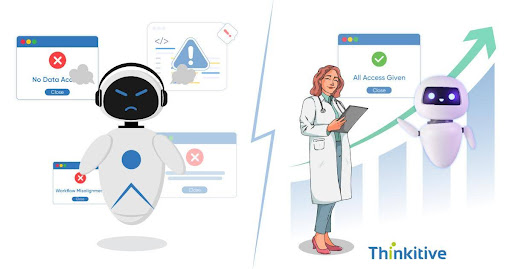If you have been to any executive meeting lately, chances are you’ve heard the word “AI” tossed around more than once. Everyone is talking about AI transformation and hoping for better, smarter healthcare delivery. But here is the truth: most healthcare AI implementation projects don’t live up to the hype.
They stall, they underdeliver, and some even don’t move beyond the pilot phase. It’s not that the tech isn’t powerful; it absolutely is. But it’s often misaligned with high-stakes realities of data silos, chaotic workflows, and overloaded staff. Plus, you can’t just plug AI into your workflows without understanding what is going to be used for, whether it is for streamlining workflows or solving a specific issue.
In reality, AI is not an omniscient solution. For instance, it can automate repetitive tasks, but AI cannot fully replace the human judgment necessary in healthcare. It needs planning, thoughtful and seamless integration with tools as well as workflows, along with more human-centered design to perform at its best. Most importantly, it needs to be designed to solve the right problems and not waste time on problems it can’t solve.
In this blog, we will uncover AI project pitfalls and what stops you from successful clinical AI adoption, while presenting you with a healthcare AI roadmap, giving you the right way to implement AI solutions in your practice.
So, let’s get started!
The Procurement Trap: Why Buying AI, Like Software, Guarantees Failure
One of the most common healthcare AI project pitfalls that fail is at the very beginning, when you buy the solution. Many organizations think that buying clinical AI is similar to selecting an off-the-shelf software. They go on choosing software based on features, dashboards, and promises, without completely understanding how well it will go with their workflows and tools.
This mindset becomes a major trap. AI tools may look great in a demo, but what if they don’t fit into your workflows or support user adoption? It will be nothing but a wasted investment that will collect dust after going live. A successful healthcare AI implementation strategy isn’t just about what AI can do; it’s about how it will work for your clinicians.
Then comes the issue of AI vendor evaluation. It is no secret that vendors often oversell; they promise outcomes without talking about the hard stuff. For instance, they don’t talk about EHR integration, navigating messy data, or training your care teams. So, selecting a vendor based on their sales pitch and not evaluating their capabilities becomes another reason for AI project failure.
Even more damaging is the misalignment between leadership expectations and frontline realities. If your healthcare AI selection process doesn’t involve both leadership and clinical input, you’re setting up for disappointment.
Avoiding this procurement pitfall means slowing down, asking harder questions, and evaluating not just what AI can do, but whether it’s truly ready to do it in your healthcare environment.
The Integration Nightmare: When AI Meets Healthcare Reality
As mentioned earlier, AI solution implementation not only depends on features, but its success depends on whether you integrate it well. EHR AI integration looks easy until you actually get into it. It’s a lot trickier with legacy systems, and most AI vendors aren’t built to handle their complexity, with their APIs and data formats.
After this comes the AI data challenges. The AI needs data to bring out its complete functions, but the problem is that patient records are not so easily accessible or in a usable form. Healthcare data is fragmented and locked behind permissions or technical barriers. If your AI is only as good as the data, then it becomes a major roadblock to success.
And let’s not forget the people: your staff. When you do not pay attention to clinical workflow integration, it brings trouble later on. Clinicians do not adopt the AI tools when they interrupt established processes, without seeing anything to show for it.
Finally, addressing the elephant in the room: legacy infrastructure. Many hospital systems were never built for real-time data processing or supporting cloud-based AI models. So, without upgrading the foundation, even the best AI strategies can grind to a halt.
In short, if you’re not ready for the hard work of integration, you’re not ready for AI.
The Adoption Crisis: Why Clinicians Reject AI Solutions
The definition of success for any healthcare AI implementation is not only with complete integration or how well the software is working. It also depends on how well the people accept and use it. And unfortunately, clinical AI adoption often gets sidelined in favor of features or executive priorities.
However, without a proper healthcare change management in health IT, AI can quickly become just another tool that gets ignored or outright rejected. So, we have given some key reasons why providers push back:
| Barrier | What It Looks Like | Impact On AI Adoption |
| Insufficient Clinical Engagement | Clinicians aren’t involved in AI selection or workflow design | Leads to low relevance, poor usability, and early resistance |
| Training and Support Gaps | One-time training sessions, no hands-on demos or follow-ups | Users don’t understand the value; confidence and usage drop |
| Trust and Transparency Issues | Black-box algorithms with no explanation of recommendations | Creates skepticism, especially in high-stakes decision-making |
| Workflow Incompatibility | AI disrupts routines without adding clear benefits | Clinicians revert to old methods or bypass the AI tool entirely |
The Compliance Minefield: Navigating Healthcare AI Regulations
If you ask any provider what troubles them most in implementing any tool, the answer would be mostly the same: navigating compliance and regulations. This is the same for healthcare AI implementation; the compliance phase means that one misstep can lead to patient safety issues, legal violations, or failed audits.
Here are the four biggest regulatory challenges providers need to navigate when working with AI tools:
- Navigating Regulatory Landscape: Between FDA AI regulations, HIPAA requirements, state-specific laws, and accreditation standards, keeping your AI systems compliant isn’t easy. Many organizations underestimate the time and expertise needed to align AI technology with this complex legal landscape.
- Data Privacy & Security Pressure: AI systems process massive amounts of patient data in real time. But if they are not designed with HIPAA AI requirements in mind from the start, you risk exposing sensitive healthcare data or violating privacy laws unintentionally.
- Lack of Clinical Validation: With AI tools, you can’t deploy them without real-world testing. If your system hasn’t been validated in clinical environments, it can produce unreliable results, and that’s a major red flag for clinical AI governance.
- Audit Trails & Documentation Gaps: Regulatory bodies expect transparency. If your AI systems cannot explain their decisions or maintain proper documentation, you are not just risking fines; you are compromising trust.
In short, compliance isn’t just a one-time thing; it’s a continuous process that must be embedded into your AI strategy from day one.
The Success Blueprint: Proven Framework for Healthcare AI Implementation
When it’s time to roll out the AI solutions, being hasty can be a big mistake that can cost you your success. This is why creating a thoughtful healthcare AI roadmap that plans your every step and tells you what will work and what can endanger the project is crucial.
Below are the key dos and don’ts to follow if you want real clinical AI success, not just another failed pilot project:
Dos for Successful Healthcare AI Implementation
- Align AI with your clinical and organizational goals while prioritizing use cases that will bring you long-term benefits and solve real problems for clinicians.
- Start small and roll out the project in phases, and after it proves valuable, then expand. This strategy is best for building trust and minimizing disruptions.
- Set performance goals and gather before-and-after data to compare the increase in productivity that AI tools brought you.
- Focus on change management, educate your teams, and build a culture ready to embrace innovations.
Don’ts That Derail AI Projects
- Don’t skip stakeholder engagement; involve your clinicians, patients, and other staff so they can understand and accept the changes quickly.
- Do not directly deploy the solution across the organization; first, test in real workflows to ensure it works properly.
- Don’t assume people will adopt AI just because it’s available; train them well to use it and know its benefits.
Follow this, and you will complete the AI project quickly and efficiently with almost no hurdles along the way.
Conclusion
Although AI has the potential to transform the way you work, it needs careful planning and thoughtful selection. The successful healthcare AI implementation is trickier than it looks. You need to avoid all AI project pitfalls, from flawed procurement to failed integration and clinician resistance.
With the right roadmap, success is not just possible, it’s repeatable. So, want to future-proof your AI investment? Then click here, and we will get started right away with the process.
Frequently Asked Questions
- What are the most common reasons healthcare AI projects fail during implementation?
Most healthcare AI projects fail during implementation because they overlook real-world clinical workflows, underestimate integration with EHRs, and lack clinician buy-in. Add messy data, vague goals, and poor training, and it’s no surprise the AI ends up underused or abandoned before it ever delivers value.
- How can healthcare organizations evaluate AI vendors to avoid implementation failures?
Healthcare organizations should look beyond flashy demos and dig into real-world proof. Ask: Has the AI been clinically validated? Can it integrate with your EHR? What support is offered post-implementation? Involve clinicians early, and choose vendors who understand healthcare, not just tech. That’s how you avoid regret later.
- What are the key technical challenges when integrating AI with existing EHR systems?
Integrating AI with existing EHR systems isn’t as simple as flipping a switch. You’re dealing with outdated interfaces, inconsistent data formats, and limited APIs. Add in siloed systems and real-time processing demands, and suddenly, even the smartest AI struggles to function the way it was designed to.
- How do you get clinical staff to adopt and use AI tools effectively?
To get clinical staff to adopt AI tools, involve them early, show how it solves their pain points, and keep the tech simple and intuitive. Pair that with hands-on training, real-world success stories, and ongoing support, and you turn skeptics into champions.
- What compliance requirements must healthcare organizations consider for AI implementations?
Healthcare organizations must navigate a mix of compliance requirements when implementing AI HIPAA for data privacy, FDA regulations for clinical safety, and state laws for operational standards. It’s not just about checking boxes; it’s about building trust, ensuring transparency, and keeping patient data safe while the tech does its job.
- What are the hidden costs of healthcare AI implementation that organizations should budget for?
Beyond the sticker price, healthcare AI comes with hidden costs, such as integration with outdated EHRs, staff training, workflow redesign, compliance audits, and ongoing system tuning. If you’re not budgeting for these, that “smart” investment can quickly turn into a slow, expensive headache. Plan smart from the start.
- How long does a typical healthcare AI implementation take from start to finish?
A typical healthcare AI implementation takes anywhere from 6 to 18 months, depending on complexity, integration needs, and internal readiness. It’s not just about installing software; it’s about aligning teams, workflows, and data. Move too fast, and you risk failure. Go smart and steady, and success becomes scalable.
- What change management strategies work best for healthcare AI adoption?
The best change management strategies for healthcare AI adoption start with involving clinicians early, offering hands-on training, and clearly showing how AI makes their work easier, not harder. Ongoing support, open feedback loops, and celebrating small wins go a long way in building trust and long-term adoption.
- How do you measure the success and ROI of healthcare AI projects?
You measure the success and ROI of healthcare AI projects by looking at real-world impact, faster workflows, improved patient outcomes, reduced errors, and cost savings. If your AI tool is making clinicians’ jobs easier and boosting operational efficiency, that’s when you know it’s paying off.
- What infrastructure requirements are necessary for successful healthcare AI deployment?
To deploy healthcare AI successfully, you need more than just software; you need strong data infrastructure, secure cloud or hybrid systems, real-time EHR integration, and scalable computing power. Without these, even the smartest AI can’t function effectively or deliver reliable, actionable insights where it counts most.






